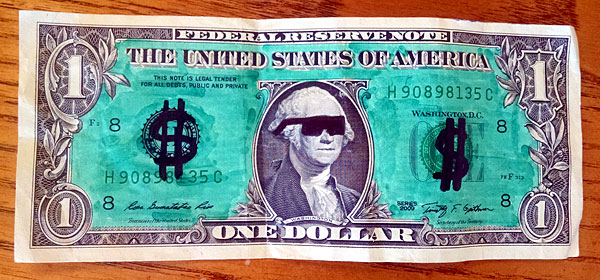[Since last month’s post about teaching kids financial independence, I’ve received a TON of awesome comments and stories from parents sharing how they teach their kids about money at home. Today’s post is from a longtime Budgets reader, Shane H, who has implemented a weekly allowance for his kids and is teaching them how to budget, save, and give to charity!]
****
Money is a powerful tool. In fact, you could argue that money is the most powerful tool in the world if you know how to use it correctly. As adults we read finance blogs and books to increase our knowledge, but what about our children?
How do you teach kids about money?
That is the journey that my wife and I currently find ourselves on. Drawing heavily from the ideas laid out in The First National Bank of Dad, we have put together a system to begin the process of teaching our 5 and 6 year olds about personal finance at a young age. It all starts with the allowance.
Why give kids an allowance?
I know, I know. Allowances can be divisive in the FI community. However, we have chosen to give our children weekly pocket money for one simple reason: It is the easiest way I can think of to begin giving them real interaction with money.
Is the money linked to chores?
My kids’ allowance is not linked to doing chores at home. That doesn’t mean that they don’t do chores in our household (they do). It simply means that they aren’t paid to do chores around the house. They do chores around the house because they are a part of our family and everyone is expected to chip in and help out around the house. They also receive an allowance, given for the purpose of beginning to teach them how to think about and use money. Those 2 things (chores and allowance) are not linked. This will also keep them from deciding when they are older that they don’t think what they are being paid is worth it and refusing to do chores.
How much allowance to give?
This was one of the trickiest questions about the whole process of teaching kids. How much money is the appropriate amount to give to a child? If you give them too much, you don’t teach them that money is a scarce resource. But give them too little, and they will be frustrated because they can never afford to buy anything. They should get enough that they can save up to purchase something that they would want in a reasonable amount of time. Delayed gratification is good, but not too delayed!
What we have settled on is 1 quarter per week for each year of age, and since they are so close in age we just pay them both at the rate of the younger child .
So, how does this work exactly?
We give our kids their allowance once a week. Monthly seemed to be too long to make them wait for it at their age, and doing it every week allows us to have small conversations about money management more frequently. We have chosen to do the allowance every Sunday morning for two reasons:
- Every Sunday morning I cook a special breakfast (egg in a hole), so it was easy to stack the money habit of an allowance on top of an already existing habit of a special breakfast.
- An important component of handling money in our family is generosity, so getting their weekly allowance right before we go to church gives them an easy pathway to be generous with it.
The kids have three different things that they can do with their money once it is given to them.
- Put at least 1 quarter in their church bag to give to the church. This is the only thing that I tell them they have to do.
- Put quarters into the spending piggy bank
- Put quarters into their savings piggy bank
How they divide their money between their spending and savings accounts is up to them. Money they put into their savings piggy bank (an M&M minis container that holds quarters in a perfect stack) is earmarked for a special savings goal that they select. Once they pick a goal, they are told which line on the piggy bank they have to save up to before they can reap the reward.
A few example savings goals they have chosen so far:
- Dinner at Sonic – $5
- Going to the movies – $20
- Zoo trip – $20
- Mini-golf – $20
- Getting nails done – $10
To encourage saving, every quarter the kids put into their savings piggy bank is matched by a quarter from me. This is to help reinforce the idea that saved money is worth more than spent money.
You might have guessed that going to the movies costs more than $20 for a family, and you would be right. And that is fine. What is important is that they are saving money for a tangible reward. Once they reach any financial goals, we try to celebrate that same week if possible. They don’t know this part yet, but the rewards are paid out of our pockets while the money they saved is deposited into a bank account in their name for later in life.
Meanwhile, any money that they choose to put into the spending bank is theirs to spend on whatever they would like. This bank stays in their room so they know that they have full ownership of it. Thus far I haven’t had to step in and overrule any of their purchases, but I do reserve the right to do so in certain rare situations. But for the most part, this money is theirs to spend as they please.
An allowance opens the door to teach kids about money
Handling money this way has opened the door to lots of conversations about money with my children. It turns requests to buy candy at the grocery store into a money lesson about how many quarters it costs. It turns that dollar store toy that they just had to have, purchased with their own money, and broke before they got home experience into a valuable lesson about saving a little longer to buy quality things.
As they get older, the system will go through changes as they begin to learn about investing, debt, compound interest and other elements of financial responsibility. But for now this approach has begun to teach them about work ethic, saving, spending, and generosity, and that is good enough for me.
*****
Shane is married and has three young children. He is a public school teacher in Oklahoma and is passionate about teaching and, you guessed it, personal finance! Shane and his wife have adopted two children internationally and are very engaged in the adoption community. In his spare time, Shane enjoys reading, playing video games, and covering the Philadelphia Eagles for The Painted Lines.
Get blog posts automatically emailed to you!





We do something very similar with our 14 year old and 9 year old. We also don’t link money to chores for the same reason but we give them a dollar a week per their age. We then make them tithe and encourage them to save 50%, or at least 20% since they need some control over their money. I constantly tell them that if they learn to live on half their income they will be set for life and that it is easier to spend than to save.
It’s a lot of money, but it also allows us to say no to a lot of requests because if they really want something they have their own money and they can realize their desires have a cost, which is pretty hard if Mom and Dad buy everything.
Thanks to this blog, my 14 year olds savings are earmarked to pay our insurance deductible if needed when he is finally old enough to drive. Great tip.
Great to hear Sara. I never shared this, but that insurance deductible my parents made me have actually came in handy. When I was 17 I crashed my Dad’s car. A pretty big wreck, totally my fault. Since we had full comprehensive insurance I covered the deductible, and I was able to hold my head up high and take full responsibility. The crash itself was shameful and I was embarrassed, but I was always proud of admitting fault and being able to cover the financial consequences without affecting my parents.
After the car was repaired, I was back driving in no time. My parents never held a grudge or punished me. It was a very humbling experience!
That worked out really well! We don’t carry comprehensive since we prefer the savings that comes from driving old cars into the ground, but we plan on giving him our dented 2010 Civic that Dad is currently driving if son seems responsible enough since we live in a semi rural area. In that case, replacement will be up to him if anything happens and hopefully I can have your parents attitude.
Great article! We need much more on this very important topic.
According to published reports, only 17 states require high school students to take a course in personal finance. I was actually surprised to see it was that many! But things are starting to shift and a push to teach money management to kids in school is building. Until then, the onus is upon us, the parents, to teach our kids the most basic, life-survival skill.
We’ve just started my 4-year-old with the three money jars – Give – Save – Spend – and we also do a reward chart system for him. At the end of each week he can choose between a prize of under $10 or take $6 in cash to distribute into his jars.
The challenge with being in the digital age is that kids never see us physically save money — they only see us spend it. We are trying to demonstrate tangible ways to show our boy that we are saving and giving — not just spending.
Thanks Jason. I’m collecting a bunch of other responses, stories and ideas for parents to share around. I agree this is a great topic.
One thing I’m really interested in watching is the Great Wealth Transfer play out over the next few decades. Baby Boomers will be transferring ~$60 trillion in assets and wealth down to the generations beneath them.. But the wealth will only stick around as long as the “children” know how to handle it. For people that don’t know how to handle $100 properly today, they will never be able to handle $1M properly later. It all starts with teaching our kids better personal finance habits :)
I think you’re setting a great example here Joel.
I think it’s vital for a child’s growth and transition into teenage life to understand the fundamentals of money and although it sounds cliche, that it doesnt grow on trees!
Understanding the actual value of money and exploring the possibilities of saving/investing money is something a lot of adults can’t fathom so being taught it young is extremely beneficial.
Thanks for the great post, as per usual Joel!
This post was actually written by a reader of the site, Shane! All credit to him :) Thanks for the encouragement Rami!
We give our daughter $10.00 a week in allowance for chores, but she has three jars and all she gets are $1 bills. $7.00 goes to her, $2.00 goes to savings, and $1.00 goes to church. It’s easy and it teaches saving and charity.
I always loved holding bills instead of coins as a kid. :)
So cool to hear so many people are teaching kids about charity. Thank you George!
I love this topic! I’m always reading what other parents are doing. This is what I wrote back in February when J. Money was talking about the subject: https://treatsandtreasure.com/how-we-do-allowance/.
Great article Tracy – thanks for sharing!
Joel,
This is a fantastic post about teaching kids the value of a dollar.
My parents gave me an allowance of $1 every Sunday – with the potential to earn more money doing chores around the house. That was probably the best lesson my parents taught me – that to earn more money, you have to work hard.
Thanks for the tips!